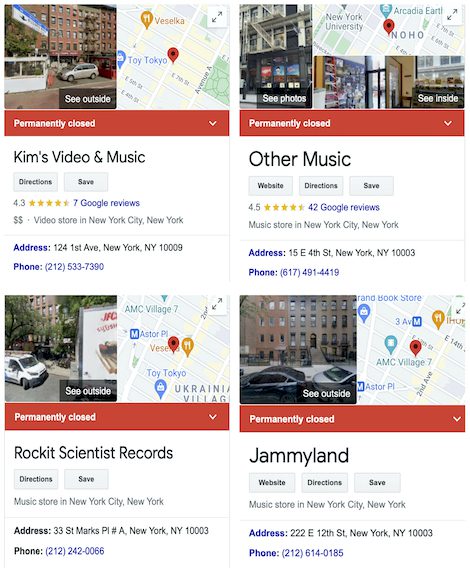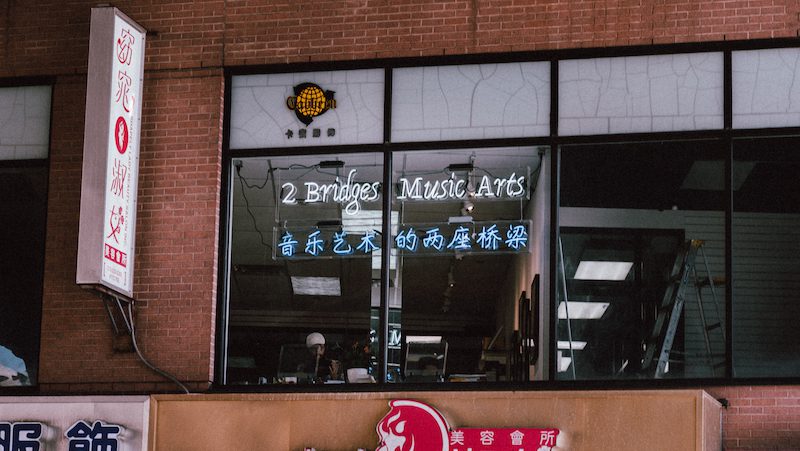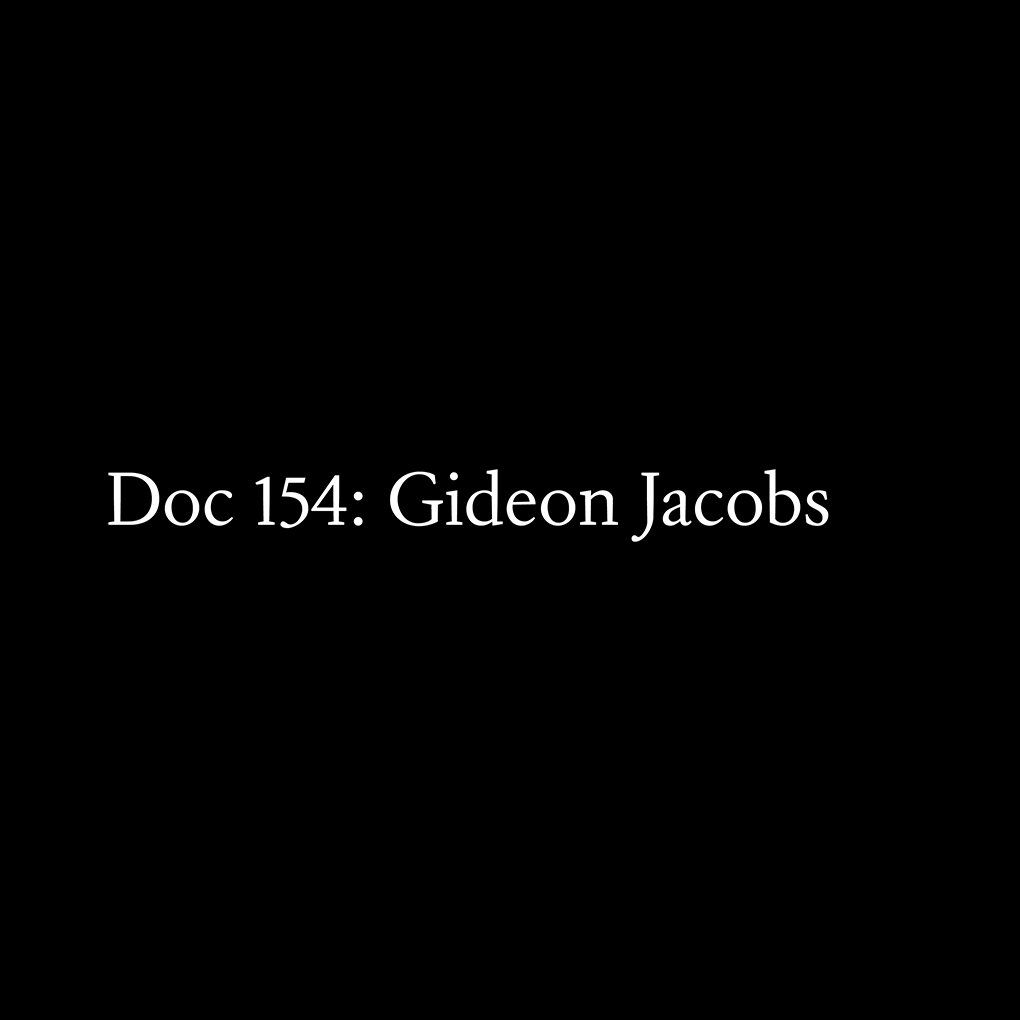
In February 2021, less than five years after it opened along a humdrum stretch of East Broadway, Manhattan, 2 Bridges Music Arts went out with a whimper. A bitter sigh. The record store (if that’s what it was) had lasted out much of the pandemic, opening up for a few days here and there, days when the streets outside were frigid and slippery, when not a single customer came through its doors. Businesses across the city were closing. Millions of New Yorkers were furloughed. Still, the landlord wouldn’t hear of rebates. Throughout the country vinyl sales were going up and up, but customers were increasingly remote. Buying records on Bandcamp meant you didn’t have to risk sharing dubious air on the F train to the neighborhood. Or rub shoulders with strangers while flicking through racks of imported techno. Or hand over bank cards, wads of bills. Material things… in a seamless world.
2 Bridges wasn’t a record store I dropped by every week or even every fortnight. Once upon a time, in the years after I moved to the city, there were quite a few places in the East Village I used to drop by daily. Etherea, Satellite, Kim’s, and Rockit Scientist on St Marks Place, Jammyland: a recessional to make me rheumy. Later there was Hospital Records where I once bought a CD by Runzelstirn & Gurgelstøc that came in a ziplock bag full of shit. At one point 3rd Street, between Broadway and Lafayette, had three branches of Tower Records; on the opposite side was Other Music which, especially on weekends, was jammed with urgent, bright-eyed youngsters buying releases new and reissued, legit and not really, by Momus, La Düsseldorf, Antipop Consortium, Vashti Bunyan, Tony Conrad. The noticeboard was a riot of flyers and postcards for club nights in nearby venues. I’d meet friends at the shop—“Here is New York”. I took this city for granted. I thought it would last forever.

By 2016 this city seemed a thing of the past. A figment of the imagination. One afternoon in spring, on the day Other Music closed forever, I joined hundreds of fellow well-wishers and funeralists on a parade down Bowery and onto Delancy, all the way to the Bowery Ballroom where, for the next five hours, the likes of Matana Roberts, Yoko Ono, Helado Negro, and Bill Callahan parped, skronked, caterwauled, exhaled. It was a nice way to say goodbye—to the store, to a time when New York teemed with independent and underground music, to our hungry, idealistic younger selves.
I walked home feeling rueful, alone. What was I still doing in this city? Give it up, man. I found myself thinking of a website called The Ghost in the MP3 I’d recently stumbled across. On it musical analyst Ryan Maguire had created a piece assembled from all the sounds lost in the process of Suzanne Vega’s 1987 “Tom’s Diner” being compressed into MP3 form. The song’s dynamic range had been shorn, its peaks and troughs disappeared. It sounded too loud. A bit lumpy and inert. This made it more consumer-friendly and easier to ping across devices, but also gentrified. Maguire’s salvaged version of “Tom’s Diner”, made from all those parts of it that “modern life” deemed superfluous, fizzed, and gurgled. It was eerie and exciting, alive. I remember feeling worried too: was this what everything was like? Was pretty much everything I was hearing—from cell phones and laptops and digital everything—a neutered lie? A kind of burial site? How could I be starved of so many vibrations and frequencies and not even know it?

2 Bridges, which was and wasn’t a record store, which perhaps existed and maybe I hallucinated, was to be found on the second floor of a Chinese shopping mall under the Manhattan Bridge. Nearby were beauty salons, fashion shops, cheap dumpling houses, messy auto repair sheds. The mall itself was gaudily strip-lit, sometimes played tinny Sino-pop that could have been made by a teenage vaporwave fan for all I knew, and mostly housed traders selling shoes that looked remaindered, orthopedic, from 1983. There seemed to be only one floor, but if you swerved right, climbed an anonymous staircase, passed a few desolate fabric cubicles and turned a couple of corners, there you’d find 2 Bridges. Through its glass exterior you could see shelves neatly lined with printed matter and vinyl, a wall from which hung a modest selection of art works, and, by the listening decks at the back, a window that overlooked East Broadway.
It didn’t have lots of records, but the records it did have felt like a fever dream. Instead of tepid indie rock and mopey hip hop, it stocked jaw-to-the-floor releases from labels such as Discrepant, Blackest Ever Black, Príncipe in Lisbon, Osaka City’s EM Records, Stroom in Ostend. Here was Polish DIY, Russian IDM, Dutch cassette experiments from the 1980s, Singapore drone music, homemade Latvian art pop, field recordings from Papua New Guinea. A record divider read “Avant Egyptian Break Beats”. I once bought a prominently displayed LP entitled Arthur Boto Conley’s Music Workshop Presents: Sounds Transferred from Various Outdated Media to a Maximum of Physical Space (On A Flat Polyvinyl Chloride Disc). (Its cover sported a photograph of a young Werner Herzog and the words “I love it very much, but I love it against my better judgement”. On another visit I bought two copies of Sounds of Silence, an Italian compilation devoted to completely silent music.
2 Bridges felt like a cabinet of curiosities. Here were records from all over the world, records about which online searches often yielded little information. Most of them were new. Where had the owner heard about them? How on earth did he expect to sell enough copies to cover international shipping costs? Being there provoked all sorts of questions it seemed vulgar to ask. Better to keep the mystery chained. Whenever I met or took friends to the place they would be baffled. Like me, they’d grown used to New York becoming ever more insular and myopic—a city that didn’t even know it was a shiny backwater. Like me, they had given up on being annoyed about this state of affairs: who wants to be seen as a curmudgeon or harking back to an irretrievable past? So what was this thing that could have been—but wasn’t—a private club, a pop-up, (grimmest possibility of all) a “concept” store?

2 Bridges opened at the tail end of 2016 not long after I’d published a short volume for a series commissioned by MoMA PS1 as part of its Greater New York show. I’d written about how everything seemed to be disappearing—mom ‘n’ pop stores, gardens, the scent of the past. Other Music’s closure seemed to confirm the sense of New York ending. And then, miraculously, along came 2 Bridges. It didn’t particularly dwell on the past or peddle overpriced reissues and boxsets to comfortably-off middle-aged men. Its book selection was improbable too—titles on geology, volcanoes, Chinese mysticism, Marxism, graphic design from the Middle East, dictionaries of Rastafarian slang, Henry Flynt arcana. They were as in-between, unlikely, hermetic as the records with whom, I often felt, they formed an occult free improvisation unit. Finding these books and records, being exposed to them, so near and so adjacent, in this place of all places, in this time of all times, never stopped being a miracle. Hope for the hopeless. Being here always felt like being in an ark, a hazy sanctuary, a worldly conversation.
 Quite a few people liked 2 Bridges. But not enough of them went there, or often enough, or spent enough when they did drop by. Moneyed types took one look at the site and wanted in, setting up naff micro-galleries on the same floor. Outside, around East Broadway, speculators were talking up the area as the next big thing. Old time businesses were moving or being moved out. Chinatown, which had never fully recovered after 9/11, was—and is—under duress as never before. Simon, the owner of 2 Bridges, was very smiley in 2016; less so in 2021. He knew what was happening, his small part in its curdling. He knew that, in New York as in any other city, if you’re the kind of person that cares about dreams and derangement, possibilities and perversity, the abiding need for otherness, you have to stay hopeful, to fight the good fight. But fighting is exhausting. In the end he stopped. Upside: all the stock was hugely discounted. Downside: everything else.
Quite a few people liked 2 Bridges. But not enough of them went there, or often enough, or spent enough when they did drop by. Moneyed types took one look at the site and wanted in, setting up naff micro-galleries on the same floor. Outside, around East Broadway, speculators were talking up the area as the next big thing. Old time businesses were moving or being moved out. Chinatown, which had never fully recovered after 9/11, was—and is—under duress as never before. Simon, the owner of 2 Bridges, was very smiley in 2016; less so in 2021. He knew what was happening, his small part in its curdling. He knew that, in New York as in any other city, if you’re the kind of person that cares about dreams and derangement, possibilities and perversity, the abiding need for otherness, you have to stay hopeful, to fight the good fight. But fighting is exhausting. In the end he stopped. Upside: all the stock was hugely discounted. Downside: everything else.
It’s October 2021. 2 Bridges, the record store that was also many other things—lighthouse, cloudy dissensus, pieces of a jigsaw that could never be completed, declaration of dependence—is no longer here. Most people don’t and won’t miss it. Most people never knew it existed. It’s gone and New York is a quieter, even more quiescent place. But I believe in ghosts. And I once read about ghosts in the machine. I tell myself silence is never silence. That I must auscultate madly.
Music is a hungry ghost.
I need you and I want you and I love you.
One day we’ll be together again.
Sukhdev Sandhu directs the Colloquium for Unpopular Culture at New York University and runs the Texte und Töne publishing imprint.

